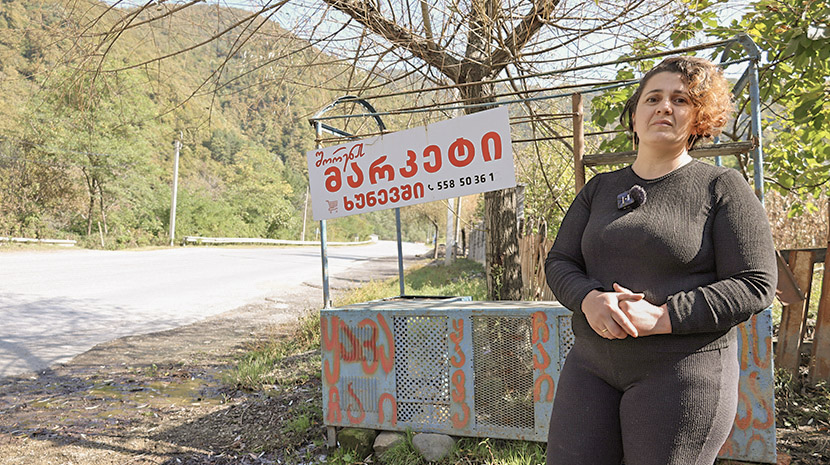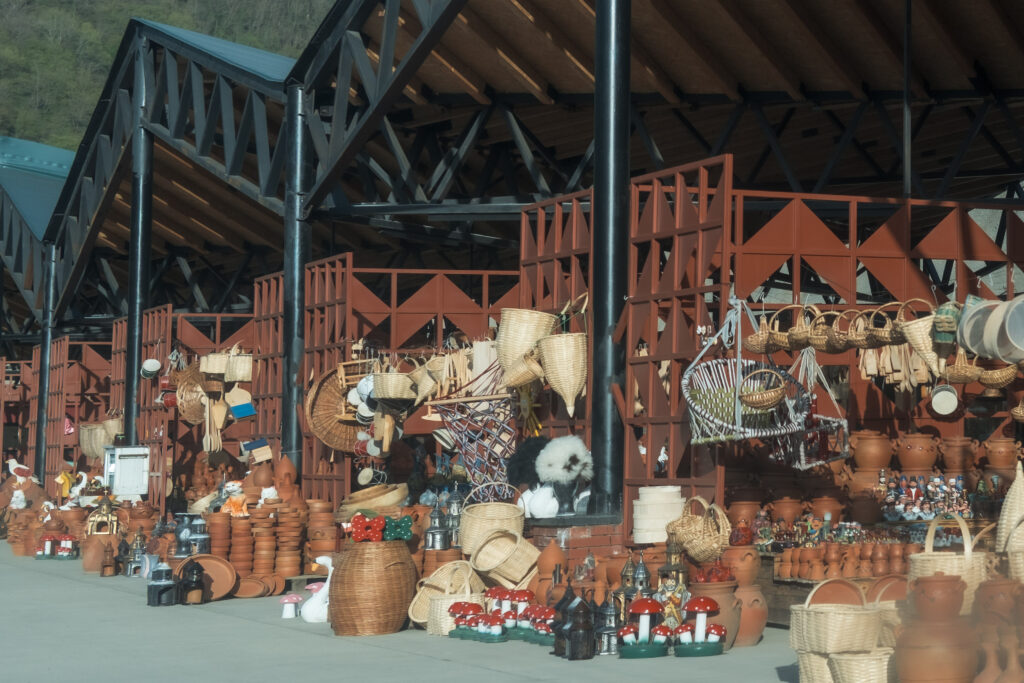Bypass: the hidden social toll of Georgia’s East-West Highway on its towns and villages
Story by Mariam Patsatsia, community support coordinator, CEE Bankwatch Network
Supported by international development banks and promoted as a strategic corridor linking Asia to Europe, Georgia’s East-West highway is central to the country’s ambitions of becoming a regional transit hub. With a price tag of EUR 1.2 billion, much of which is financed through loans from the Asian Development Bank (ADB), European Investment Bank (EIB), and the World Bank (WB), the highway construction project was framed as a symbol of progress, promising speed, connectivity and economic growth.
This headline figure, however, does not reflect its actual cost, and the dominant narrative completely leaves out its local impact. As the highway reroutes traffic away from towns and rural communities, small businesses, markets and roadside economies are collapsing, and some villages are losing their connectivity to transport links. Promises of relocation and recovery have largely failed to materialise, and communities were left to bear the burden of progress they were never part of.
Kharagauli Municipality: communities falling off the map
‘When the new road opened almost three years ago, I lost everything,’ says Shorena, a mother of two whose life was turned upside down when traffic was diverted from her village, Khunevi, to the newly completed sections of the East-West Highway. Cars disappeared overnight, and with them, the steady stream of customers her family had come to rely on. For years, the old route passed directly by her house, where her family had set up makeshift stalls in front of the gate. They sold local produce: fruits, vegetables, mushrooms, and homemade colourful, flavorful jams. Today, though Shorena’s name still appears in bright red on the signs above, the stalls remain empty.
Her family now gets by on her husband’s wages from the very construction project that erased their livelihood. What will happen to us in a year or so?’ she asks, fearing the loss of that final income once the remaining part of the highway is complete.

Shorena’s story is far from unique. In her own municipality alone, more than 200 families who once made a living trading along the old route have seen their daily income disappear, according to estimates from Chemi Kharagauli, a well-regarded local outlet with deep ties to the community. In villages of Makatubani, Boriti, Ubisa, Vashlevi, Khunevi, Khevi and Sakasria in Kharagauli Municipality, while financial compensation was offered to those whose businesses were physically displaced by the highway construction, many traders and restaurant owners bypassed by the new route received no or marginal support.
The fallout is especially acute in Khunevi and Gedsamania, two villages that also lost direct access to the highway. Without a functioning link, residents are forced to travel 5 to 9 kilometres to the nearest junction in Vertkvichala. Municipal transport services introduced after the disruption have proven inadequate, particularly for women, many of whom lack access to cars or a driver’s licence and now rely heavily on male relatives or neighbours to meet their mobility needs. Teachers, pensioners, and low-income families have been hit hardest, with many residents choosing to leave altogether in search of work in cities or abroad.
In a letter signed by more than 240 Khunevi residents and sent to the Roads Department — the agency overseeing highway construction — locals warned of growing isolation, especially during winter months. The department’s response was blunt: due to difficult terrain and safety requirements, only two interchanges were feasible in the region, with no additional infrastructure planned. Khunevi and Gedsamania will remain stranded.
Khunevi residents are frustrated: the new highway cuts them off, the bus shelter is collapsing, streetlights stay dark, and highway construction waste litters the village. Source: Chemi Kharagauli
Zestaponi Municipality: a tale of decline, and one of survival
When the old road descended from the mountains into the lowlands, it once ran directly through Zestaponi and its beloved coffee street — a lively stretch of cafés and roadside diners that offered weary travellers a welcome reprieve. Today, that road no longer leads here. The highway now bypasses the town entirely, and with it, the transformation of the coffee street appears complete. The windows of empty buildings now bear the dispiriting signs of decline — ‘For Rent’ or ‘For Sale’ are plastered everywhere.
‘Out of more than 40 cafés, just six or seven of us are still open,’ says Nino (not her real name), who is running one of the remaining diners with her family. ‘And most of those are owned, not rented. The renters simply couldn’t survive.’ But even those who’ve managed to keep their doors open barely stay afloat. Nino says her family took out a GEL 100,000 (about EUR 32,000) loan to open the business. ‘Now the customers are rare, income has dropped, and I’m still GEL 22,000 [EUR 7,000] in debt,’ she says.
Across her place, at a once-busy nearby café, only one table is occupied — a group of three middle-aged women enjoying coffee and sweets. A young waitress, one of just two remaining staff members, seems content with being outnumbered. ‘We’ve lost 60 to 70 per cent of our customers,’ she says. ‘We manage only because of the loyal ones who still come. They know us, and they keep choosing us.’ When asked about other job opportunities in the town, she gives a tired shrug. ‘Maybe a supermarket job. Or otherwise, leave the town.’
The effects of the highway bypass are being felt across Zestaponi, even at the local market. ‘Khachapuri bakeries [on the coffee street] used to buy cheese in bulk, which pushed prices up,’ told Tamari, a dairy vendor at the Zestaponi market to Batumelebi news outlet last summer. ‘Now that cheese isn’t selling, prices have fallen, and people [farmers] can’t afford other essentials, which keep getting more expensive.’ With dwindling incomes and few alternatives, like in Kharagauli, many have left, abandoning their family homes in search of work abroad.

Shrosha, a village in Zestaponi municipality known for its deep-rooted ceramic traditions, has managed to avoid the worst of the economic fallout that hit surrounding areas thanks to the uniqueness of its craft. The local pottery culture is central to the livelihood of nearly every household. Artisans shape Shrosha’s distinctive, locally sourced clay by hand and fire their work overnight in brick kilns, producing vessels admired by local and foreign travellers alike. When the construction of the new highway diverted traffic away, the once-thriving vendor hub lost its purpose. They were offered relocation. However, the offer came late— when most families were already facing financial hardship — and brought more uncertainty than reassurance.
Against the dull greys of the highway, the new marketplace stands out with its garish display of earthy brown clay pottery. Though the market has not officially opened, several dozen vendors have already moved in out of necessity. Among those who settled early is Nia (not her real name). With the diverted traffic, her family lost its primary source of income over a year ago and has struggled to stay afloat. ‘Winter was especially hard,’ she says, explaining that moving into an unfinished space was the only way to get by. Although official project documents promised compensation if residents saw their incomes decline, on the ground, no one in Shrosha or the neighbouring villages has received a payout.
Nia also knows she will have to relinquish part of the space she currently holds once the market officially opens, and more traders arrive. She is willing, but anxious. The state plans to sell the property, and with privatisation, rent is expected to follow. Nia also worries that not everyone was counted in the initial survey, and some will be left out of the already limited new market space.
Meanwhile, transportation has become another hurdle. For Nia and fellow artisans, getting to the market now means driving five kilometres and crossing a river that divides the village — an added expense in fuel that didn’t exist before. Those unable to drive rely on family members to drop them off by car and make the return journey on foot to save costs. Despite repeated appeals to the Roads Department and local municipality, the promised bridge remains unbuilt, which would significantly cut travel distance and time. ‘We asked [for the bridge],’ Nia says. ‘They haven’t said no. But they haven’t done anything either.’
Managing discontent: broken bargains
The social and economic fallout of Georgia’s new East-West Highway was embedded in its blueprint. Four separate Social and Environmental Impact Assessments (ESIAs) were prepared for the 50-kilometre stretch of road built since 2018. Still, none of them acknowledged the devastating impact it would have on local economies and communities. Despite safeguard policies from lenders like the ADB, EIB, and World Bank, which mandate greater consideration of local livelihoods and mitigation of a highway’s adverse impacts, the East-West highway project failed to account for local realities or deliver progress to communities.
For roadside vendors in Kharagauli and the cafés on Zestaponi’s coffee street, the ESIAs acknowledged that reduced road traffic would hurt business, but suggested that businesses could shift to serving the local community. That was never realistic. These stalls and cafés were built for travellers, not locals, and adapting to a new customer base would require support to make these costly changes. This support was never genuinely offered, and the Roads Department, overseeing the highway, botched the process. In Kharagauli, the department and municipal government tried to contain the public backlash by setting up a new market in Sakasria. But vendors dislike it. The stalls are tucked away from the main road, out of sight of passing traffic. ‘No one would see us. No one would stop to buy anything there,’ says Shorena, the woman who traded local produce in front of her home. ‘They told us only those who insisted the most would get a spot,’ Shorena recalls, suggesting the authorities were more interested in managing complaints than offering a lasting solution.
To owners of cafés in Zestaponi, local officials pointed to a potential site near the Shorapani junction, promising space within one-and-a-half to three years. But business owners now say that timeline misses the point—by then, they would be out of income and already rebuilding their lives. In April 2024, the local municipality expressed interest in constructing an alternative site, which failed to attract bidders.
Even among those most directly affected by the highway’s construction, few question its national and strategic importance. However, the highway has come to represent exclusion for many local communities along the route. Quietly, they admit the road is a good thing—for others. For them, it has brought little more than loss. Still, few dare to speak out. Expressing concern meant standing in the way of development, going against the state itself or serving the interests of opposition parties. These communities were first placated and then shamed into silently enduring the costs of progress. ‘They calmed people down with nice words. That’s the truth,’ says Tiko, a café worker in Zestaponi, recalling how authorities assured them the traffic diversion was temporary. ‘They did everything they could to stop people from speaking out,’ she says.

The information in this story is drawn from conversations and interviews with locals during the author’s field visits to the East-West Highway and the villages of Zestaponi and Kharagauli municipalities over the past year.
